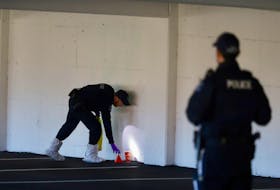UPPER NAPPAN, N.S. – The earth-eating monster known as the Oxford sinkhole continues to cut a swath through tax-payers pocketbooks.
Mike Johnson, emergency measures office (EMO) co-ordinator for Cumberland County, provided an update on those costs during a recent meeting of Cumberland county council.
“It cost $13,000 for the fencing that had to be done, and the ground penetrating radar was $35,000,” said Johnson.
The cost of 24-hour security is $10,000 every three weeks, and the total cost of security now exceeds $10,000.
“We put in fencing to keep people out because people were still walking up to the sinkhole and taking a look in,” said Johnson.
“Even after the fencing was up, we had to put in 24-hour security because people were coming in at night when nobody was around,” he added. “And even with 24-hour security people were sneaking in and finding a way around.”
A ground penetrating radar test was deployed to check if radar could penetrate through the salinity of the water and into the ground. The test cost $1,500.
It was supposed to take a rough snapshot of what is occurring beneath the surface, providing direction for future seismic testing. Unfortunately, the ground penetrating radar failed to live up to its billing.
“We got the report back now, and I would say from a preliminary view of it we’re somewhat disappointed because the penetration of the radar only went down three to five metres,” said Johnson. “Five metres only gets us to the 15-foot mark, so we’re not getting down to that area where we want to see what’s going on.”
Geo-technical experts are currently looking at the data to determine if the preliminary review was accurate.
“Other options they could use with ground penetrating radar is changing the frequency,” said Johnson. “A longer wavelength of frequency penetrates deeper and gives deeper information, however, with a longer wavelength it tends to reflect off of large objects, so you don’t get as clear a picture.”
If ground-penetrating radar can provide a better picture, a larger ground penetrating radar survey, at a cost of about $35,000, could be deployed. Another option is seismic testing and drilling at a cost of between $75,000 and $100,000.
How all of this will be paid for is being worked out.
“The way it usually works is that, typically, the municipality will pay for things to the limit it’s capable of doing so,” said Johnson. “Beyond that, they would be looking at the provincial government to assist to the level that they’re capable of doing so, and then, from there, to the federal government to the limit they can provide.”
A dip in the highway
There is a dip in the Trans-Canada Highway near the entrance-ramp to Oxford in the west-bound lane heading to Amherst.
“The hole closest to the centre of the road has been paved over a couple of times,” said Johnson. “But what happened just recently was, on the white line at the rumble strip, that area began to dip down and has since been paved.”
Johnson said there is also a dip in the ditch and the road-bank adjacent to the dip in the road, adding the provincial government is monitoring the dips.
“They’ve had people down to look at it and they’re doing twice-daily checks to ensure that it’s safe,” said Johnson. “And they’re looking at options, along with us, to see what is most effective way to determine the sub-grade.”








